The more Corsair products I use, the more I’m convinced the company is completely in tune with its core demographic. A cursory glance at Corsair’s rapidly expanding catalog of gaming mice is a testament to that. From the Harpoon RGB to the Scimitar RGB Pro, Corsair mice offer myriad bells and whistles with the reliability and durability both competitive and casual gamers demand.
Corsair’s latest offering, the Glaive RGB, is no different. Built for speed and precision, the Glaive is no doubt a mechanically sound and efficient gaming mouse. Coming in at $69.99, the Glaive’s price point nestles snugly between the M65 Pro and Scimitar Pro RGB and provides gamers with a suite of features from both mice. But don’t worry; it brings a few new tricks of its own to the game, too.
It may not be the absolute best mouse in Corsair’s expanding line (although that’s still up for debate), but it undeniably fills a niche and provides a wonderful experience on multiple fronts.
Looks and Swagger: The Glaive RGB is a Beautiful Piece of Hardware
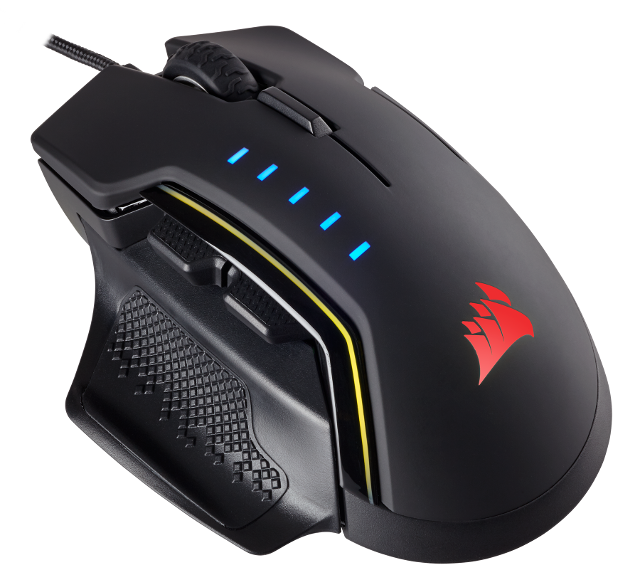
We’ll get to specs in just a second, but I want to first talk about how gorgeous this mouse is. The Glaive RGB is the most strikingly elegant mouse in Corsair’s line. Its sleek, contoured design is accentuated by sharp cuts and angles near the front, which lend it a mechanical look from that angle. More so than its brethren, the Glaive RGB looks sophisticated and futuristic — it’s not as clunky-looking as the M65 Pro, but it provides much more visual pop than the Harpoon RGB or Katar.
On top of that, the Glaive employs the same three-zone RGB backlighting customization that Corsair uses in many of their other mice and keyboards. That means by using Corsair’s CUE customization software (which keeps getting better and better, by the way), you can fully customize the color on the Glaive, from the light strips on either side of the mouse to the Glaive’s grills across the front and the Corsair logo emblazoned on the aft of the mouse.
I know it’s odd to say, but the Glaive carries with it an aura of class. It’s not trying to do too much, but it’s also making a statement: Bright and flashy aesthetics don’t always mean gaudy and fantastic button arrangements.
Unboxing the Glaive
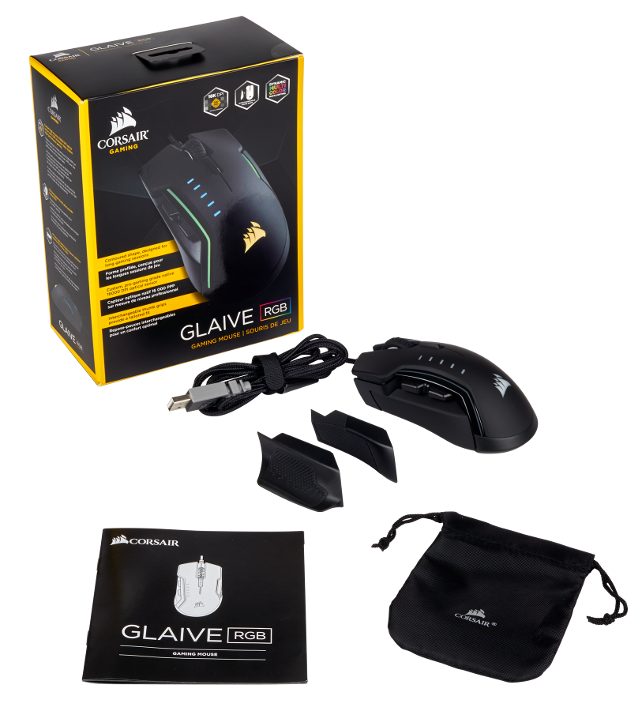
As with all Corsair products, the Glaive comes packaged in a sturdy box that doubles as a quick and easy-to-use carrying case. In addition to the mouse and a user manual inside, Corsair also provides three interchangeable thumb grips that offer gamers a trio of tailored fits for increased comfort during gameplay.
What I especially like about these grips is that each easily snaps onto and off of the left side of the mouse with minimal effort. Unlike other mice, you won’t need any tools, making substitution on the fly effortless, even during fierce multiplayer matches.
What’s more, I found that each grip provided a different benefit, depending on the game I was playing. The thumb rest variant proved beneficial for slower games like Ark: Survival Evolved and Subnautica, where quick movements were few and far between. But the more traditional rubberized thumb grip offered added control for twitch shooters like Counter-Strike: Global Offensive. The third variant, a conventionally smooth thumb grip often found on other mice, proved a bit slick for my personal taste. But nonetheless, its inclusion affords players a viable third option.
The mouse features standard L/R buttons, Omron switches guaranteed to last 50 million clicks, two shoulder buttons, a middle column button with an aluminum, rubber-grip, clickable scroll wheel, DPI cycling button, and a durable braided cable.
Functionality & Feedback: Where the Glaive Really Shines
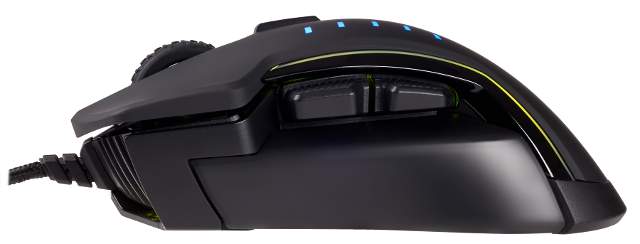
The Glaive provides some great accuracy and stability. In Paladins, I was able to pull off monster headshots and crits with Victor and Tyra, taking my game from a typical 20-12 to an average of 32-8 over 10 or so matches — a massive upswing in performance. And it was because the Glaive is so responsive.
I won’t lie: the Glaive took some getting used to. As I’ve said in other reviews, my every-day mouse is a wireless Razer Type-R II, and while it’s a great mouse for my needs on a regular basis, it’s not nearly as responsive as its wired counterparts — like the Glaive. So there was a bit of a (re)learning curve when it came to Glaive, but it didn’t take long to slip back in those comfortable Corsair shoes.
The Glaive’s Buttons are Airy, but Responsive
The L/R buttons on the Glaive are light and tad bit airy, but hyper-reactive nonetheless. That means I was able to click them as fast as I could and they responded over and over again, which came in handy in more than one firefight. But the great thing about the Glaive’s new Omron switches is that they’re not only responsive, they’re also accurate. Given their slight airiness, it wouldn’t be surprising if I made a few accidental clicks here and there, but that never happened in my more than 30 hours with the Glaive.
On top of that, one of my favorite things about the Glaive is how big the L/R buttons actually are. Taking into consideration a plethora of grip styles, both traditional and hybrid, the Glaive’s left mouse button is clickable from the front of the mouse all the way up to the top of the DPI selector light-rail.
On the other side, the Glaive’s right mouse button is clickable nearly to the back of the mouse – more than ¾ down the side. This feature really comes in handy if you’re working or playing in a confined space and need to change your grip as you move the mouse around.
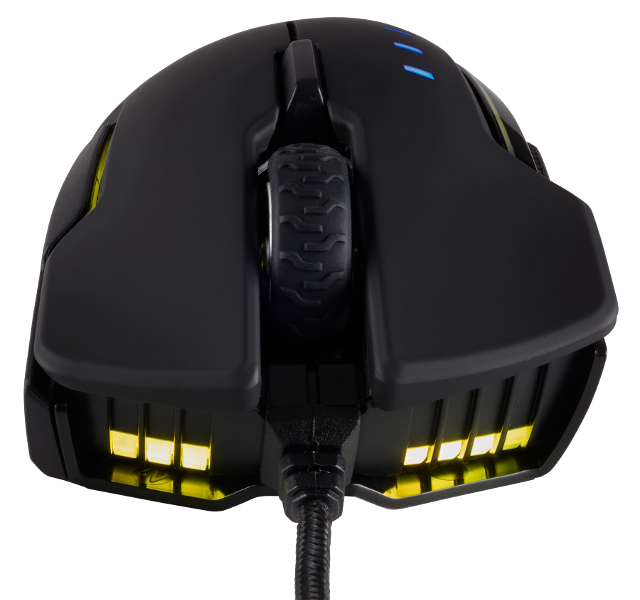
Where the L/R buttons feel well-made, the Glaive’s shoulder buttons feel cheap. Regardless, they are just as responsive as the L/R buttons, requiring only the slightest touch to activate. And just like the L/R buttons, these shoulder buttons took a bit of getting used to. Where the shoulder buttons on my Razer Type-R II require a methodical push to activate that sometimes compromises my grip on the mouse, the Glaive’s larger shoulder buttons are decidedly more sensitive and easier to find.
Rolling your thumb up from the thumb rest and pushing slightly in will easily activate the buttons. And while the shoulder buttons aren’t so responsive that an accidental touch will activate them, they are responsive enough that a light press that doesn’t compromise your grip most certainly will.
The Glaive’s rubber-gripped aluminum scroll wheel feels nice and is positioned high enough that you’ll never accidentally click the L/R or DPI cycle buttons while scrolling. It’s accurate enough that switching weapons in Battlefield 1 is a breeze, but it’s not as fast as I’d hoped for.
Scrolling through web pages took a few more spins of the wheel than I’m typically used to. The button beneath the scroll wheel is a bit awkward, too, but considering how all scroll-wheel buttons are a bit awkward, the Glaive’s falls in the more user-friendly end of the spectrum.
And lastly, the Glaive’s DPI cycling button is placed nicely enough, although moving to it can be cumbersome at times, especially if you’re a palm-grip player. Outside of that, it’s a responsive button that allows you to quickly cycle through the Glaive’s five available DPI settings, all of which are customizable using Corsair’s CUE software (the stock DPI settings are 800; 1,500; 3,000; 6,000; and 9,000).
What I do really like about the Glaive – on top of mostly everything else – is the DPI selector light-rail, which is a nice user experience touch, providing quick and easy reference for which DPI setting I’m actually using. It’s not a big deal, per se, but it’s definitely one I appreciate more than I thought I would.
The Glaive’s Sensor is Damn Good
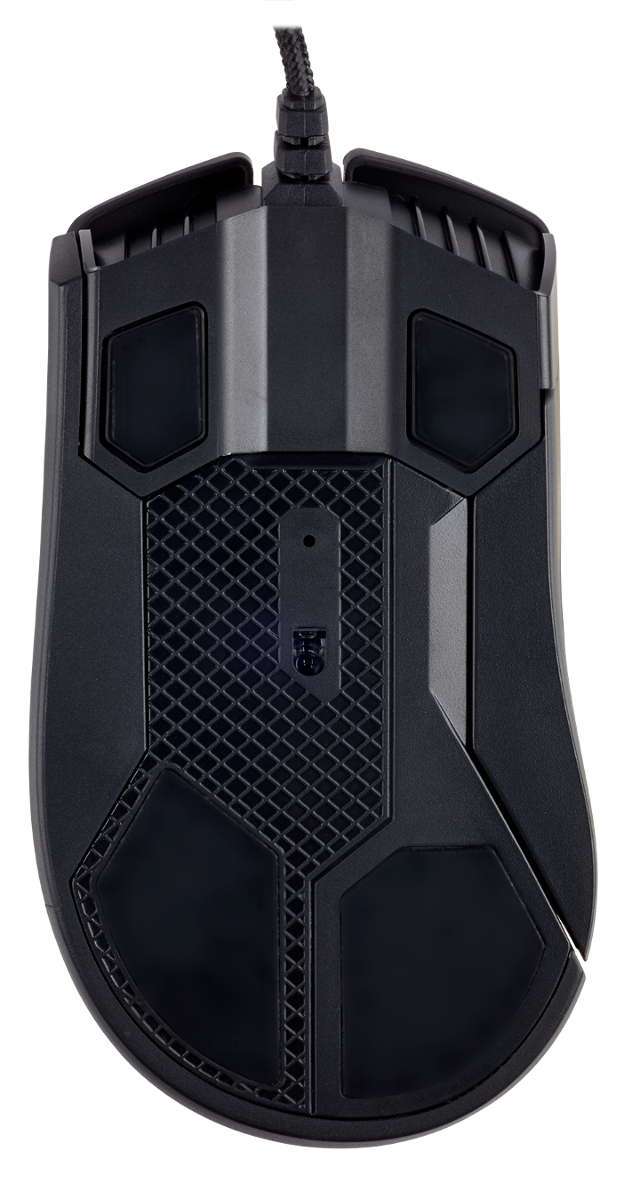
Much like Corsair’s Scimitar RGB Pro, the Glaive uses a custom pixart sensor that brings high-performance and crazy-reliable accuracy right to your desktop. Where all of Corsair’s other gaming mice – sans the Scimitar – only go up to about 12,000 DPI, the Glaive is able to hit that elusive 16,000 DPI setting for ultra-speedy sniping or radically precise movements in the RTS and MOBA space.
On top of that, the Glaive also allows users to fully customize their DPI settings from 100 to 16,000, settable at 1DP steps, allowing the Glaive to be fine-tuned to any mousepad or surface type. Accentuating this is CUE’s ability to calibrate the Glaive to any play surface as well.
Typically, I play without a mousepad on a less-than-optimal desk covered in divots and scratches from years of moving (yeah, I need a new desk …). But the problem I often run into is that the sensor on my Razer Type-R II sometimes gets lost in the maelstrom, causing my cursor (and avatar) to freeze while I turn the mouse off and on – or frantically shake it until it comes back to life.
But with the Glaive, it doesn’t matter that I’m lazy and won’t get a mousepad – or that my desk has seen better days. Instead, I’m able to calibrate the Glaive in CUE and get continued and reliable response from the sensor day in and day out. And that feels really good.
Lastly, the polling rate for the Glaive is pretty insane. When Corsair claims that the Glaive provides “ultrafast 1ms lag-free gameplay” they really mean it. The Glaive executes your actions precisely and with minimal delay. Where a typical non-gaming mouse will send a signal to the PC about every 8 milliseconds, the Glaive sends a 1,000Hz signal every single millisecond, meaning that your movements, no matter how rapid, are registered for high-precision, which really makes a difference in those to-the-fire firefights in Paladins.
Comfort
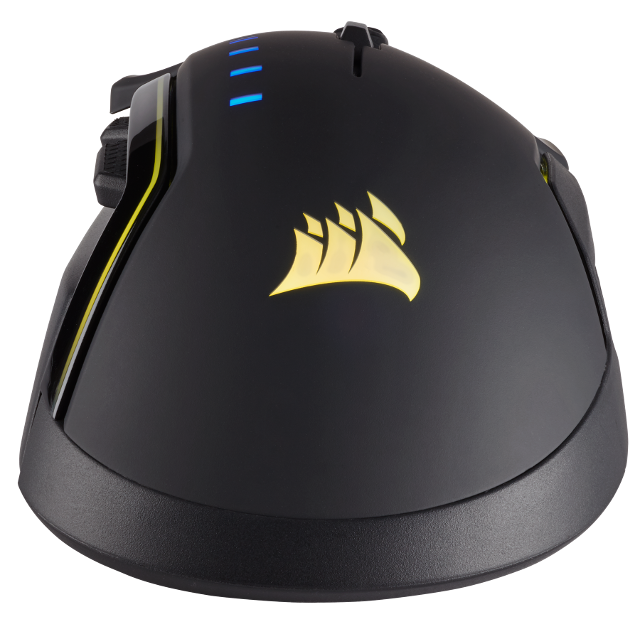
Corsair stresses that they put a lot of emphasis and comfortability with the Glaive – and there’s no doubt they did. But I can’t help but feel a little disappointed in that arena. Sure, the Glaive’s uniquely contoured and sculpted chassis fits myriad grip styles, but its slick surface sometimes makes these grip styles uncomfortable or obtuse.
I’m a palm player and while it took some time to get used to how high my hand rests on the Glaive compared to even the Scimitar Pro RGB, the one thing I couldn’t quite get over was how slippery the Glaive felt – specifically with the thumb-rest grip. In that configuration, I often felt my palm slipping up and down, which caused me to grip the mouse harder and my hand to get fatigued.
Ultimately, I remedied the situation by switching to another thumb-grip (thank you, Corsair for providing more than one). But I can’t help but think that while the Glaive’s finish provides for increased ease-of-movement, it was a bit of an oversight to make it so slick.
But overall, the Glaive RGB is a fantastic feeling mouse that may make claw-grippers feel more at home, but it is suited for gamers of all grip styles. Even after 30 hours of play and a few 8-hour marathon sessions, my hand never got tired once I found my optimal configuration.
Verdict
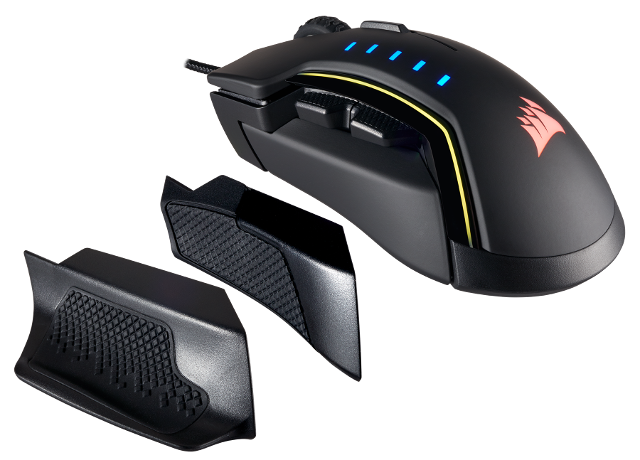
Corsair’s Glaive RGB is a highly responsive, low-latency mouse that provides moderate to high comfortability an incredibly versatile set of grip styles. It’s reliable and accurate with a powerful and consistent sensor that expertly performs on numerous surfaces. It’s a mouse that delivers on nearly all of its promises and doesn’t pretend to be something it’s not.
Coming into Corsair’s peripheral catalog between the M65 Pro and Scimitar RGB Pro, the Glaive combines into a responsive and elegant package a lot of what makes those mice great. At $69.99, the Glaive is one of the more comfortable mice in its price range – and it provides the precision and functionality of a mouse that carries double the price.
The Glaive RGB isn’t the best gaming mouse on the market, but it isn’t claiming to be. It’s lightweight frame and precise angle snapping make it ideal for FPS players, while it’s fully customizable DPI settings let RTS and MOBA players dial in the accuracy they need to move across the battlefield. At the end of the day, the Glaive provides a well-made reliable product to competitive and casual gamers who are looking for quality without breaking the bank.
And that’s just something you can’t argue with.
[Note: A Glaive RGB review unit was provided by Corsair for the purpose of this review.]

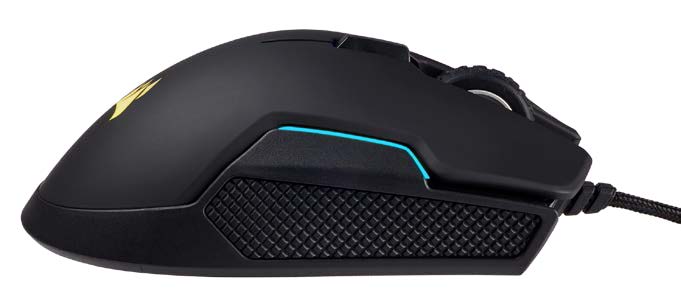








Published: May 4, 2017 08:55 am